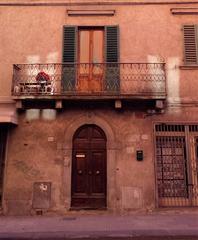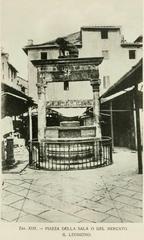Fortezza Santa Barbara, Pistoia: Visiting Hours, Tickets, and Historical Sites Guide
Date: 04/07/2025
Introduction
Nestled in the heart of Pistoia, Tuscany, Fortezza Santa Barbara stands as a powerful symbol of the city’s layered history and enduring cultural vitality. An outstanding example of Renaissance military architecture, the fortress invites visitors to explore its centuries-old bastions, panoramic ramparts, and evocative courtyards. This guide provides a detailed overview of the fortress’s origins, architectural evolution, key historical events, and everything you need to know for an enriching visit—including up-to-date hours, ticketing, accessibility, and nearby attractions.
For the latest visitor information, consult official resources such as Visit Pistoia and the Ministero della Cultura.
Table of Contents
- Introduction
- Medieval Origins and Early Construction
- Renaissance Transformation under the Medici
- The Fortress in Military History
- Risorgimento and Political Imprisonment
- 20th Century Decline and Restoration
- Architectural Features and Legacy
- Visiting Fortezza Santa Barbara: Hours, Tickets, and Tips
- Frequently Asked Questions (FAQ)
- Conclusion
- Call to Action
- References
Medieval Origins and Early Construction
The beginnings of Fortezza Santa Barbara trace back to 1331, when the Florentine Republic constructed a fortification to assert dominance over Pistoia after military victories in the region (Wikipedia; Museionline). The original structure, known as Fortezza di San Barnaba, was erected near a chapel dedicated to San Barnaba (Vivipistoia). This early fortress featured a trapezoidal plan and a central tower (mastio), elements still present in the current layout.
In 1343, the citizens of Pistoia destroyed the fort as an act of rebellion against Florentine control (Museionline). Nevertheless, the strategic site retained military significance, with remnants later integrated into subsequent fortification phases.
Renaissance Transformation under the Medici
The most significant transformation occurred in the 16th century, under Cosimo I de’ Medici, Grand Duke of Tuscany. To solidify Medici authority and modernize city defenses, Cosimo I ordered extensive reconstruction beginning in 1539 (Wikipedia; Visit Tuscany). Military engineer Nanni Unghero led the initial phase, with Giovan Battista Bellucci (Il Sanmarino) and renowned architect Bernardo Buontalenti later contributing to the fortress’s expansion and adaptation to new military technologies (Visit Pistoia).
Key changes included:
- A quadrilateral, bastioned plan with sloped walls and cannon embrasures, reflecting advances in artillery warfare (Museionline).
- Integration of the medieval central tower (mastio) into the Renaissance structure.
- Expansion to connect with city walls, enhancing urban defense (Visco91).
- Addition of barracks, warehouses, gardens, and a chapel adorned with Baroque frescoes (Wikipedia).
The Fortress in Military History
Fortezza Santa Barbara played a key role in Pistoia’s defense and governance. Its elevated position at the city’s southeast corner enabled surveillance over both city and countryside (ItaliaCuriosando). The fortress successfully withstood a siege in 1643 during the Wars of Castro, when Papal troops unsuccessfully attempted to capture it (Wikipedia; Visco91). By the late 18th century, its military role diminished, and in 1774 Grand Duke Pietro Leopoldo I disarmed the fortress, after which it served as a barracks and prison.
Risorgimento and Political Imprisonment
During the Italian Risorgimento, the fortress became a prison for local patriots and political dissidents. Between 1848 and 1850, the mastio’s walls were inscribed with poignant graffiti and drawings by imprisoned patriots—a testament to the turbulent times (Visit Pistoia; Vivipistoia). A commemorative plaque honors Attilio Frosini, executed by Austrian forces in 1849 (Visit Pistoia).
20th Century Decline and Restoration
After serving as a military prison, the fortress fell into neglect. In 1944, four young partisans were executed here by German forces, a tragedy memorialized within its walls (Visit Pistoia; Vivipistoia). Restoration in the 1970s and 1980s stabilized the structure and prepared it for new cultural uses (Visit Pistoia; Vivipistoia).
Today, managed by the Ministry of Culture, the fortress hosts exhibitions, concerts, theatrical performances, and public events, especially during summer (ItaliaCuriosando). The permanent exhibition “Fortezza d’acqua” explores the relationship between water and Pistoia’s history (Visit Pistoia).
Architectural Features and Legacy
Fortezza Santa Barbara is a striking example of 16th-century military architecture:
- Quadrilateral Plan: Massive brick and stone walls with angular bastions at each corner (Museionline; Visit Tuscany).
- Central Mastio: The original medieval tower, later used as a prison and bearing historical graffiti (Ministero della Cultura).
- Curtain Walls and Bastions: Designed to deflect artillery and provide overlapping fields of fire.
- Moat: While no longer filled, remnants are still visible.
- Chapel: Features Baroque frescoes.
- Panoramic Ramparts: Offer sweeping views of Pistoia and the surrounding countryside (ItaliaCuriosando).
Visiting Fortezza Santa Barbara: Hours, Tickets, and Tips
Visiting Hours
- General Opening: Tuesday to Sunday, 10:00 AM – 6:00 PM (closed Mondays).
- Note: Hours may vary for special events or holidays. Always verify via the official website before your visit.
Ticket Information
- Admission: Entry is often free, but some guided tours or exhibitions may require tickets (Visit Pistoia; wanderboat.ai).
- Reduced Rates: Discounts for EU citizens under 26, seniors, and groups. Children under 6 enter free.
- Booking: Tickets for special events or tours can be purchased onsite or online.
Accessibility
- Mobility: The fortress is partially accessible. Ramps and adapted restrooms are available, but some historic areas may remain difficult to access. Contact staff for specific needs.
Guided Tours & Events
- Tours: Regular guided tours (in Italian, occasionally in English) provide deep dives into history and architecture.
- Cultural Events: Open-air cinema, concerts, exhibitions, and festivals—especially vibrant in summer (Visit Pistoia).
Getting There
- Location: Piazza della Resistenza, 51100 Pistoia—just a short walk from the city center and the main train station.
- Parking: Free parking at Cellini lot nearby.
- Public Transport: Local buses stop close to the city center.
Nearby Attractions
- Cathedral of San Zeno
- Baptistery of San Giovanni in Corte
- Museo Civico
- Museo dello Spedale del Ceppo
- Pistoia Sotterranea
Photography Tips
- Best Spots: Capture the full quadrangular layout from Piazza della Resistenza or panoramic views from the ramparts.
- Events: Evening light and cultural events provide excellent photographic opportunities.
Frequently Asked Questions (FAQ)
Q: What are the opening hours?
A: Tuesday to Sunday, 10:00 AM – 6:00 PM. Always check the official site for seasonal updates.
Q: Do you need to buy tickets?
A: General admission is often free; some guided tours or events may require tickets.
Q: Are guided tours available?
A: Yes, regularly—book onsite or via official portals.
Q: Is the fortress accessible to people with disabilities?
A: Partially; ramps and facilities are available, but some areas are less accessible due to historic features.
Q: Can I visit with children?
A: Yes, children under 6 enter free, and the fortress is family-friendly.
Q: Are there special events?
A: Yes, especially in summer—check the events calendar.
Conclusion
Fortezza Santa Barbara is a living testament to Pistoia’s vibrant history, from its medieval roots and Medici-era fortifications to its role as a modern cultural center. Visitors can explore dramatic bastions, discover poignant political graffiti, and enjoy panoramic views—all while immersing themselves in Tuscany’s rich heritage.
Plan your visit by consulting the official resources for the latest information on hours, events, and accessibility. Whether your interest lies in history, architecture, or culture, the fortress offers an unforgettable experience.
Call to Action
Ready to discover Fortezza Santa Barbara? Download the Audiala app for audio tours, travel tips, and event updates. Follow us on social media and subscribe to our newsletter for ongoing news on Pistoia’s top sites and cultural happenings. Explore more of Tuscany’s treasures with our guides!
Related Articles
References
- Vivipistoia
- Ministero della Cultura
- Visit Pistoia
- Booking Pistoia
- Wanderboat.ai
- Wikipedia
- Museionline
- ItaliaCuriosando
- Visco91
Visuals:
- Include images of the fortress exterior and ramparts with alt text such as “Fortezza Santa Barbara Pistoia panoramic view.”
- Interior shots with “Baroque frescoes inside Fortezza Santa Barbara” or “graffiti from political prisoners.”
- Map of Pistoia highlighting the fortress location.

